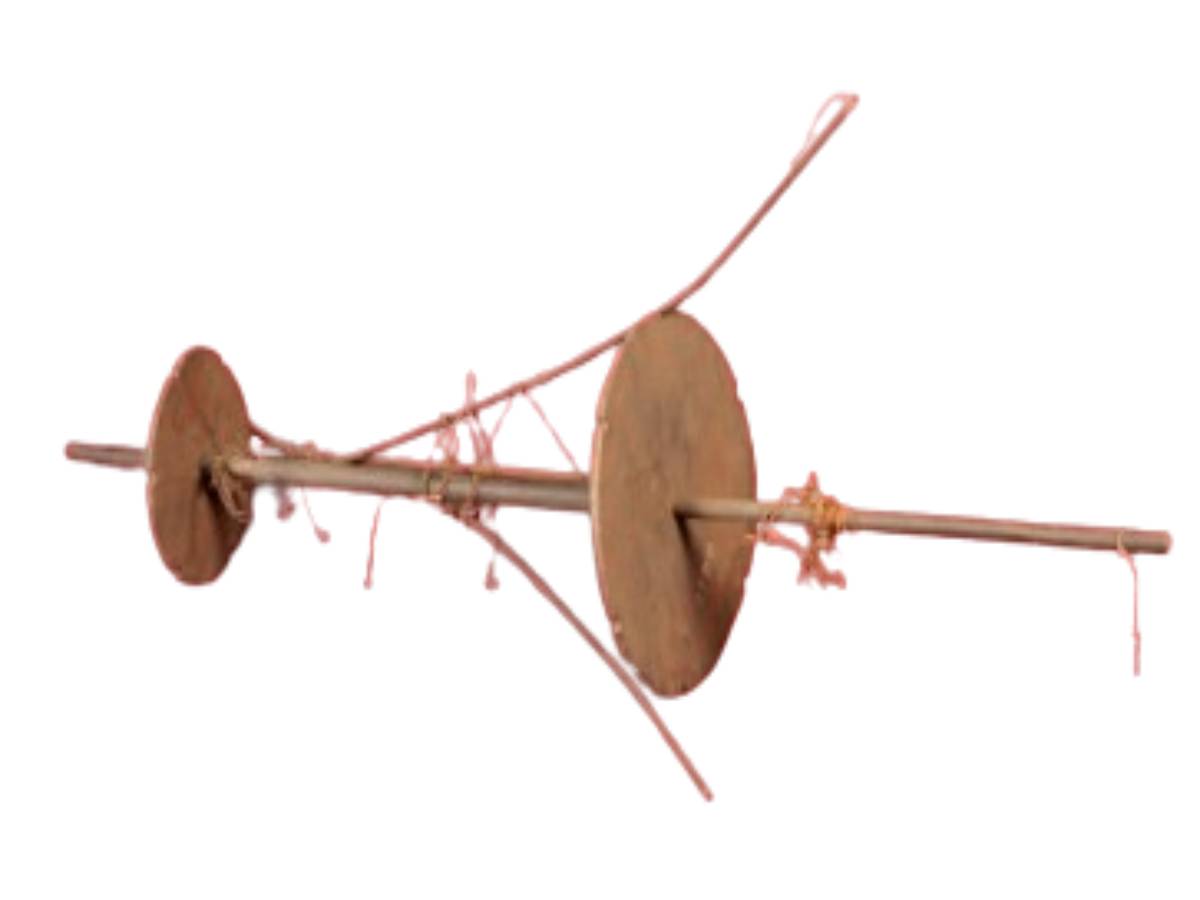State
Tribe Name
Art Type
short description
With rising changes in the art of spinning, a tool naturally associated with the trade of spinning by woman is the Natai. This is a handmade spindle made from a long wooden rod passed through 2 circular wooden discs, one large and the other small, with the hollowed outside portions made of blackened glossy wood and decorated with burn designs to preserve balance and control during spinning. Three bamboo sticks are attached on either side of the Natai to maintain the center of gravity of the spindle while enhancing its rotation without adding much weight to the design. The Natai has inscribed cultural values for and has been knitted into the lives of the Cacharis, a tribe of Assam, with practical usage as well. Stocking of the Natai spindle has, therefore, become an assumed occupation for womenfolk in which cotton or any other plant fiber is spun into a thread for later weaving into garments or home textiles. Construction of the spindle, with mechanical balance, and indigenous craftsmanship have been practically imparted through ages.
Thumbnail

Filter Postion
Left
Filter Background
Off
Theme
Filter Header Image

content
Image

description
With rising changes in the art of spinning, a tool naturally associated with the trade of spinning by woman is the Natai. This is a handmade spindle made from a long wooden rod passed through 2 circular wooden discs, one large and the other small, with the hollowed outside portions made of blackened glossy wood and decorated with burn designs to preserve balance and control during spinning. Three bamboo sticks are attached on either side of the Natai to maintain the center of gravity of the spindle while enhancing its rotation without adding much weight to the design. The Natai has inscribed cultural values for and has been knitted into the lives of the Cacharis, a tribe of Assam, with practical usage as well. Stocking of the Natai spindle has, therefore, become an assumed occupation for womenfolk in which cotton or any other plant fiber is spun into a thread for later weaving into garments or home textiles. Construction of the spindle, with mechanical balance, and indigenous craftsmanship have been practically imparted through ages.
A traditional wood spindle is said to be Natai, dating back to the Cachari tribe of Northeast India. This tool is deeply embedded in their textile tradition. The spindle is handmade, consisting of a long wooden rod running through two wooden discs-hollowed circular portions on opposite sides mounted with blackened glossy wood ornamentation with burn designs, assisting with balance and control during spinning. Fixation of rotating handle for bamboo sticks on either side effectuates spindle activity while retaining the center of gravity of the Natai without burdening spindle extra for no purpose. Today, the Natai signifies much more than just a spinning instrument; it also signifies the connection between common life and traditional knowledge systems within tribal societies. Such tools are made from raw materials available in the locality, showcasing the sustainable ways of living and nature-based intuitiveness of the tribe. Modernization has played a chief role in rendering these traditional implements to the periphery; the Natai remains a proud symbol of the cultural identity of the Cachari tribe and their artisan heritage. Documentation and preservation of such tools are of utmost importance to understand the cultural milieu and technological outlook of India's indigenous communities.
A traditional wood spindle is said to be Natai, dating back to the Cachari tribe of Northeast India. This tool is deeply embedded in their textile tradition. The spindle is handmade, consisting of a long wooden rod running through two wooden discs-hollowed circular portions on opposite sides mounted with blackened glossy wood ornamentation with burn designs, assisting with balance and control during spinning. Fixation of rotating handle for bamboo sticks on either side effectuates spindle activity while retaining the center of gravity of the Natai without burdening spindle extra for no purpose. Today, the Natai signifies much more than just a spinning instrument; it also signifies the connection between common life and traditional knowledge systems within tribal societies. Such tools are made from raw materials available in the locality, showcasing the sustainable ways of living and nature-based intuitiveness of the tribe. Modernization has played a chief role in rendering these traditional implements to the periphery; the Natai remains a proud symbol of the cultural identity of the Cachari tribe and their artisan heritage. Documentation and preservation of such tools are of utmost importance to understand the cultural milieu and technological outlook of India's indigenous communities.
Image Mode
landscape
promoted
On
Verified
Off
